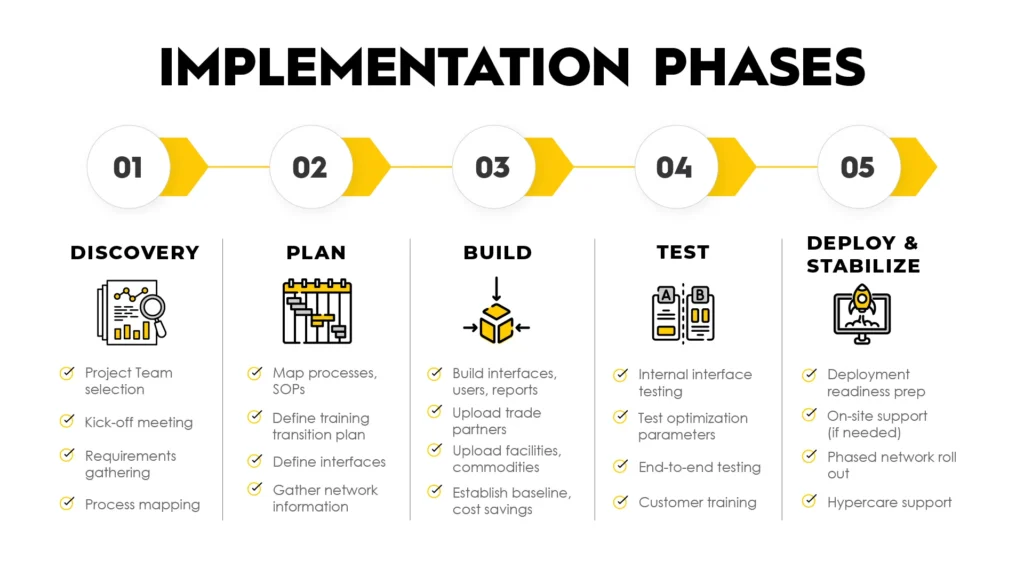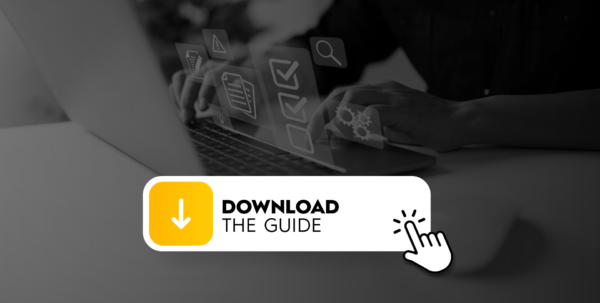
Unlocking the Power of Managed Transportation: Implementation
July 5, 2023

Managed Transportation can play a crucial role in supply chain management, and partnering with a logistics services provider can significantly enhance a shipper’s transportation department.
The benefits of Managed Transportation are realized by leveraging technology and integrating outsourced strategic resources, which seamlessly become extensions of the client’s organization.

IMPLEMENTATION PHASES
Implementing managed transportation in stages allows for a systematic approach to integrating the provider’s services into the client’s transportation department. Breaking down the process into 5-phases allows both parties to collaborate effectively, ensuring a smooth transition. This approach empowers businesses to navigate potential challenges, allocate resources efficiently, and maximize the benefits of partnering with a managed transportation provider. This five-phased approach includes:
- Discovery
- Planning
- Building
- Testing
- Deployment
While the overall structure of these phases remains consistent across each implementation project, each step is tailored to the client’s individual needs.

PHASE 1: Discovery
The goal of any reputable managed transportation provider is to become an integral part of the client’s transportation department through technology enablement and strategic partnership. To achieve this, the process must start with thoroughly assessing the client’s current processes, systems, and objectives. This involves:
- Introducing the project team, which includes representatives from executive leadership, sales, technology, operations, project management, and finance.
- Introducing key stakeholders.
- Gaining an understanding of current business processes.
- Developing a vision for the future to guide timelines and resource allocations.
- Creating initial process flows.
- Defining the operations team structure.
- Developing a project plan and risk log.
The work completed during the discovery phase will serve as the foundation for future phases.
PHASE 2: Plan
This part of the process ensures proper integration and maximizes efficiency across technology and personnel. During this phase, the managed transportation provider will design your comprehensive solution, accounting for all stakeholders, deliverables, and success measures. The deliverables of this phase include:
- Process Flows
- Standard Operating Procedures (SOPs)
- Exception Handling Requirements
- Training & Transition Plans
- Reporting Requirements
Subscribe!
Subscribe to receive the latest articles, newsletters, whitepapers, and industry news directly to your inbox.
"*" indicates required fields
PHASE 3: Build
Phase three initiates the build of all components to your specifications. During this phase:
- All master data uploads and configurations are completed.
- Code is completed and reviewed.
- Customized training materials are created.
- Trading partners, carriers, suppliers, facilities, commodities and routing guides are integrated.
PHASE 4: Test
The test phase is critical to ensuring the smoothest transition possible as the TMS goes live. Testing will reduce post deployment defects, and gain buy-in for the program by engaging different levels of customer stakeholders for sign-off.
In this phase clients can expect thorough end-to-end scenario testing and training for users, suppliers and carriers.
PHASE 5: Deployment
All systems are now operational. However, even the most successful launches may encounter a few hiccups along the way. For this reason deployment includes a 60-90 day hypercare period to ensure a smooth transition. Challenges can be overcome through continuous improvement, resource allocation, and strategic planning. The goal is to maximize results as the partnership develops.
During the initial weeks of “go-live,” your managed transportation provider should be intensely focused on offering technical and change-management support, while also monitoring reports and deployment compilation criteria.

Reaping the Rewards: Path to Success
Text: All this hard work and continual evaluation pave the way for cost reduction and financial optimization, opening doors to success through:
Hard Dollar Savings:
- Engage carrier community for procurement events and negotiate with existing providers to reduce transportation costs.
- Optimizing cost savings through modal shift and shipment consolidation.
Soft Cost Savings:
- Improve efficiencies in planning, communication, and accounting processes.
- Continuous improvement through data analysis and business intelligence.
- Streamline invoicing processes for better financial management.
Embracing Managed Transportation: Empowering Business Success
Implementing a managed transportation solution with a logistics services provider empowers businesses to streamline operations, optimize freight activities, and achieve significant cost savings. By harnessing advanced technology, strategic planning, and ongoing support, companies can maximize efficiency and gain a competitive edge in their supply chain operations. Shippers can navigate and overcome these implementation challenges by entrusting transportation management to industry experts, allowing for growth and success across the business. Together with a logistics services provider, businesses can conquer new horizons, secure in the knowledge that their logistics needs are in capable hands.
Contact us today to learn more!

